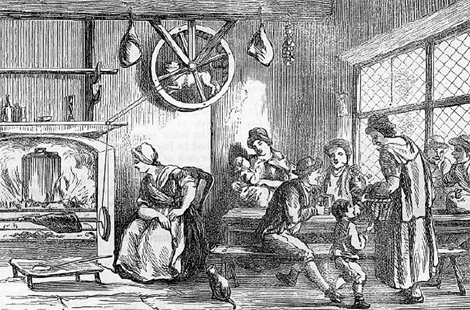
Turnspit dogs ran in wheels to rotate cooking spits over fires. Notice the cat doing bugger all to help mankind… Typical…
Yesterday in the UK was National Dogs Day – a nation of animal lovers we’re happy to canonise our pets alongside fruits and children’s authors – but something that caught my attention was the history of the turnspit dog.
This working dog, recorded as having a similar body shape to a basset hound with the head of a pit bull, was popular in England and, to a lesser extent, America, from 16th century to the end of the 19th, and spent its days walking in a purpose-built wheel that drove a spit over a kitchen fire – you can read more about them here.
This got me thinking, first about the Flintstones, and then about a more modern approach, for which there might be more in it than a spit roast chicken.

Could livestock-powered generators help more in remote villages than solar panels?
The notion of getting a dog to provide power might sound a bit workmanlike for today’s pampered pooches, yet some pet owners are happy to pay in excess of £2,000 for a dog treadmill so that man’s best friend needn’t leave the house for ‘walkies’. So why not swap the products from something that requires energy, to something that generates it?
While I’m not suggesting that we all enlist legions of family pets to power the national grid, on a larger scale, animals like horses and oxen have been used for centuries to power man’s labour – turning wheels for crushing grains, or powering pumps for mining – so it was of no real surprise to find that the idea of them powering an electricity generator in the modern world.
While governments around the world aim to bring electricity to its most remote villages by renewable means like solar panels, the technology comes with a long list of faults – affected by bad weather, difficult to repair, expensive to produce, and because of this organised crime has taken to stealing them.
Livestock power could well be the answer, with studies showing that generators can be produced from easily available parts, that produce a robust power unit at low cost, powered by a couple of easy to maintain beasts.
https://youtube.com/watch?v=FfzNCLtWDXI%3Frel%3D0%26controls%3D0
The Koshish Foundation even went as far as producing a basic CAD model simulation to work out the gear ratios, before building and testing a prototype as part of a project with NED University of Engineering and Technology, Pakistan.
The study even went as far to take into account the animal’s waste products, which can be used for fertiliser, as burning fuel, or placed in a gasifier which can produce fuel to power vehicles.
Obviously, strict animal welfare has to be taken into account, but managed properly (in a 21st century manner, as opposed to 16th century) and with some work, it looks to be an option for those most in need.
As for working dogs? I’m quite happy for them to be used for their intelligence than as a power source, but I’d still be interested if there’s a way a treadmill could be geared to produce charge for small devices. Otherwise, there’s always children to do it…






